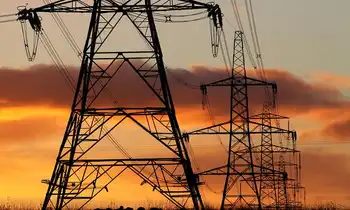Wind turbines meeting more resistance
By New York Times
High Voltage Maintenance Training Online
Our customized live online or in‑person group training can be delivered to your staff at your location.

- Live Online
- 12 hours Instructor-led
- Group Training Available
Moving turbine blades can be indistinguishable from airplanes on many radar systems, and they can even cause blackout zones in which planes disappear from radar entirely. Clusters of wind turbines, which can reach as high as 400 feet, look very similar to storm activity on weather radar, making it harder for air traffic controllers to give accurate weather information to pilots.
Although the military says no serious incidents have yet occurred because of the interference, the wind turbines pose an unacceptable risk to training, testing and national security in certain regions, Dr. Dorothy Robyn, deputy under secretary of defense, recently told a House Armed Services subcommittee.
Because of its concerns, the Defense Department has emerged as a formidable opponent of wind projects in direct conflict with another branch of the federal government, the Energy Department, which is spending billions of dollars on wind projects as part of President ObamaÂ’s broader effort to promote renewable energy.
“I call it the train wreck of the 2000s,” said Gary Seifert, who has been studying the radar-wind energy clash at the Idaho National Laboratory, an Energy Department research facility. “The train wreck is the competing resources for two national needs: energy security and national security.”
In 2009, about 9,000 megawatts of proposed wind projects were abandoned or delayed because of radar concerns raised by the military and the Federal Aviation Administration, according to a member survey by the American Wind Energy Association. That is nearly as much as the amount of wind capacity that was actually built in the same year, the trade group says.
Collisions between the industry and the military have occurred in the Columbia River Gorge on the Oregon-Washington border and in the Great Lakes region. But the conflicts now appear to be most frequent in the Mojave, where the Air Force, Navy and Army control 20,000 square miles of airspace and associated land in California and Nevada that they use for bomb tests low-altitude, high-speed air maneuvers and radar testing and development.
When the developer Scott Debenham told local Navy and Air Force officials in June that he was working on plans to install a wind turbine at three industrial locations near the area overseen by the military, they expressed opposition to all of the projects, saying that even one additional turbine would interfere with critical testing of radar systems.
The military says that the thousands of existing turbines in the gusty Tehachapi Mountains, to the west of the R-2508 military complex in the Mojave Desert, have already limited its abilities to test airborne radar used for target detection in F/A-18s and other aircraft.
“We cannot test in certain directions because of the presence of wind turbines in the Tehachapi area,” said Tony Parisi, the complex’s sustainability officer. “Our concern is construction in other areas will further limit where we can do this kind of testing.”
As a result of the militaryÂ’s opposition, Horizon Wind Energy recently withdrew three project applications in the area. AES Wind Generation said it found out in May, after nine years of planning, that the military had objections to its proposal to build an 82.5-megawatt, 33-turbine wind farm.
Mr. Debenham, a former naval officer, said he understood the concerns but that the military was overstating them. A similar turbine just went up on a nearby Marine base. “It’s standing proof that these single turbines are not an unmitigatable threat to national security,” he said. Mr. Parisi said the military was assessing whether the interference would force it to shut down the base’s turbine, which cost $6 million to install.
The impact of wind turbines on radar had been a back-burner concern for years, but it heated up in March, when the Defense Department put a last-minute halt to the $2 billion, 338-turbine Shepherds Flat wind project in Oregon out of concern the turbines would impair the effectiveness of long-range surveillance radar.
The department eventually withdrew its opposition after an internal analysis indicated the effect on radar would not be as severe as initially thought and an outside study identified measures that could be taken to mitigate the interference. However, the Pentagon soon raised concerns about another wind project in the area, saying it could interfere with the very same radar.
Mark Tholke, regional director for the wind energy developer enXco, said that the objections could make wind energy less competitive. “It makes investors and banks jittery,” he said. “They will increasingly view these as risky projects and push up the financial terms.”
Mr. Tholke said three of four wind projects in enXcoÂ’s current portfolio have been delayed because of radar concerns. One of the projects has been reduced in size to 140 megawatts from 250 megawatts to appease a military contractor worried about radar impacts.
Eliminating turbine clutter on radar is complicated. Part of the challenge is that many radar systems in use in the United States date back to the 1950s and have outdated processing capabilities — in some cases, less than those of a modern laptop computer. While there are technology fixes to ease interference on these aging systems, it can be tricky to filter out just the turbines.
On radar, “a wind turbine can look like a 747 on final approach,” said Peter Drake, technical director at Raytheon, a major provider of radar systems. “We don’t want to have the software eliminate a real 747.”
The Energy Department says the problem should be solvable through new technologies. “We are confident that investments in mitigation measures, including new coatings or materials for wind turbines, alternative configurations for wind farms, gap-filler radar or software patches, and investments over time in upgrades to modernize radar systems, will enable the continued deployment of wind power across the country,” said Jen Stutsman, a spokeswoman for the agency.
But some observers say this piecemeal approach does not go far enough.
“I can’t imagine a better example of everyone wanting to do the right thing and nobody doing it,” said Howard Swancy, an aviation consultant and former F.A.A. official. “We need an infrastructure-size development plan.”
Mr. Debenham just wants his three individual turbines to win approval. The concerns of the local military have been directed to Washington for review. In the meantime, millions of dollars in financing and renewable energy incentives are, well, twisting in the wind.
“I’m in limbo. My customers are in limbo,” he said. “Can you tell anyone in Obama’s office?”











